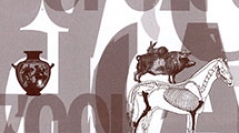

 Anthropozoologica
49 (2) - Pages 237-252
Anthropozoologica
49 (2) - Pages 237-252Hybrid camels, intentional crosses between dromedaries and bactrian camels, are prized for their robustness and endurance. They were the prime vehicles of short and long distance caravan trade in a large area between Greece and Mongolia until the whole-scale introduction of motorized transport. This paper proposes a model for the zooarchaeological study of camel hybridization as a culture-historical phenomenon based on ethnographic and ethnohistoric observations of camel wrestling. Camel wrestling spectacles involve large audiences who gather in large arenas to watch first generation male hybrid camels wrestle during the mating season. While Anatolia was chosen as a case region for testing the model, it can be applied to all regions where hybrids are expected to occur in the archaeological record.
Bactrian camel, dromedary, hybrid camels, long-distance trade, congregation